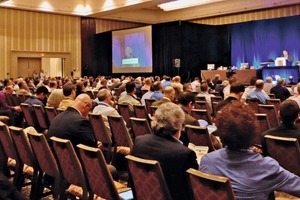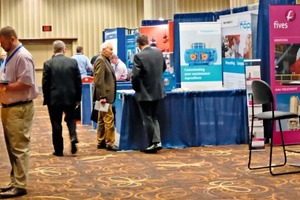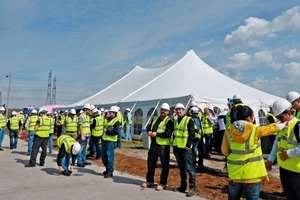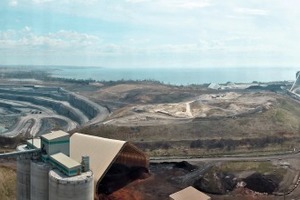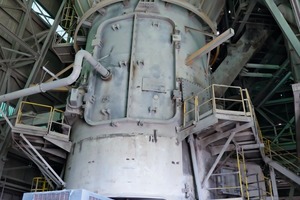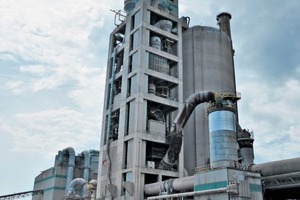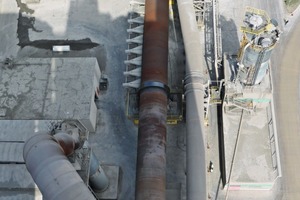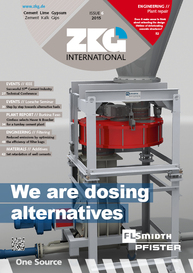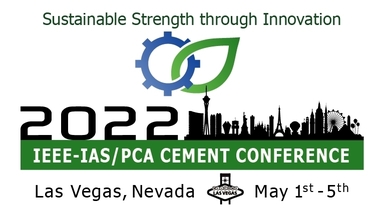Successful 57th Cement Industry Technical Conference
Around 900 participants took up the invitation issued by the Industry Applications Society (IAS) and “America’s Cement Manufacturers” (the PCA) to attend the Cement Industry Technical Conference held in Toronto from 26.-30.04.2015.
The IEEE-IAS celebrated its 50th anniversary at this year’s conference, and the society’s achievements were impressively highlighted in an image video. Cement producers, subsuppliers and people with an interest in the cement industry came from North, Central and South America, Europe and Asia to Canada’s largest city to learn, under the motto “Thinking Big”, more about the “biggest ideas” in the present-day cement industry. The conference excursion to the largest cement plant in Canada, St Marys Cement Bowmanville, also took “Big” as its theme.
The event started on the Sunday with internal IEEE-IAS meetings. In the evening, the participants had an opportunity, at the Exhibit Reception, of learning about the products and services of the around 150 exhibiting companies. Monday was reserved for General Practice tutorials and Cement Professional Training. From mid-day onward, participants then had, in parallel to the above, adequate time to obtain information from the exhibitors on their product ranges.
The conference programme itself began on the Tuesday, with the official opening by Jeff Nagel, Chairman of IEEE-IAS CIC. In his address, Nagel emphasised that the construction industry is providing a great impetus for overall economic development, especially in Toronto, where widespread building activity is immediately apparent, thus creating new jobs.
In the first paper of the day, Ed Sullivan, Chief Economist of the PCA, outlined the prospects for the North American cement industry. He made it clear to the well-filled auditorium that there are exactly three reasons for growth in the construction industry: “Jobs, Jobs, Jobs!”. Rising employment figures mean more income, more loans, and thus an increase in residential building. The number of new house-building projects in 2009 was only slightly more than 500 000, but has risen significantly in subsequent years. Sullivan expects around 1.25 million housing starts in 2015, a figure which is set to rise to some 1.8 million by 2019. Sullivan also demonstrated that the increasing number of people in employment has a direct beneficial effect on cement consumption; capacity utilisation has exhibited an upward trend since 2011, rising from only 67 % in 2012 to 76 % by 2014. Sullivan is anticipating 89 % in 2016, with annual production stabilising at around 90 % of existing capacity in the 2017–2019 period. Sullivan’s long-term analysis also forecasts further rises in cement consumption, which naturally presupposes increasing cement production, although this will then tend to remain at a relatively low rate.
Mike McSweeney, President and CEO of the Cement Association of Canada, emphasised in his keynote speech the achievements of the cement industry in climate protection. Cement remains one of the world’s most important building materials. As McSweeney noted, the industry takes its responsibilities seriously, and has done much in this field in recent years. Large investments have been made in energy-efficiency, environmental protection, reduction of CO2 emissions and the prevention of air pollution, in addition to extensive research work. “Sustainability” is nowadays a major priority at many plants, and is indeed vital, as McSweeney noted, for the survival of the industry.
The next session, focussing on “Power Generation, Distribution and Related Products”, included discussion of a “Hybrid ORC Waste Heat Recovery System and Solar Thermal Plant in Morocco”. The aim of this project is that of reducing dependence on fossil fuels and counteracting rising electricity prices. The afternoon featured two parallel sessions on “Environment, Energy and Sustainability” and “General Practices, Drives and Related Products and Automation”.
Wednesday morning, held under the auspices of the PCA, took current focuses in standardisation as one of its central topics. In the afternoon, those attending had the opportunity of examining “Blending Silo Technology” and current “Emissions Monitoring” with experts in the context of two panel discussions.
Plant tour to St Marys Cement, Bowmanville
Around 400 participants took part in the plant tour to St Marys Cement’s Bowmanville site on Thursday, and were conducted through the facilities in several groups. The plant is idyllically situated on the northern shore of Lake Ontario, employs more than 130 people, and is in operation 365 days a year. Founded in 1912 in the town of St. Marys, St Marys Cement is one of North America’s longest established cement companies. Production began in Bowmanville in 1968, at 900 t/day. A second kiln was added in 1972, increasing operational capacity to 1800 t/day. The two original wet kilns were replaced by a single preheater/precalciner kiln in the early 1990s, increasing clinker capacity to 5000 t/day. Further upgrades in the 1990s were responsible for the most recent increase, to 5800 t/day. St Marys Cement became a wholly owned subsidiary of Votorantim Cimentos in 2001.
The plant tour began with a visit to the impressive limestone quarry, located around 1.5 km from the plant itself. This quarry supplies the cement plant and also aggregates production. It currently possesses a concession for 4.5 million t/a.
The extracted limestone is comminuted in a primary (54’’ Fuller-Taylor) and a secondary (hammer) crusher. The feed materials take the form of limestone, shale/clay, iron and sand. Rates of limestone addition are monitored and controlled by means of an FLSmith QCX on-stream analyser. All materials are ground in an FLSmith Atox 45 vertical spindle mill, a 3000 kW machine which achieves a throughput of 460 t/h. The finely ground product is then stored in silos. The FLSmith preheater/precalciner was installed in 1991: the preheater is of the two-line design, with five stages and a separate calciner line. The 80 m long, 5 m diameter FLSmith rotary kilns installed in 1991 have a combined capacity of 5800 t/day. A bandwidth ranging from coal to petroleum coke, fluid coke and sponge coke can be used as fuels. Biofuels are also being tested in the context of a pilot project.
58th annual IEEE-IAS/PCA Cement Industry
Technical Conference in Dallas
The 58th annual IEEE-IAS/PCA Cement Industry Technical Conference is to be held from 15 to 19 May 2016 in Dallas, Texas. The event will include technical papers/presentations, tutorials, training and exhibits. There will also be a visit to the recently renovated Ash Grove Cement facility at Midlothian, Texas.
//www.cementconference.org" target="_blank" >www.cementconference.org:www.cementconference.org

